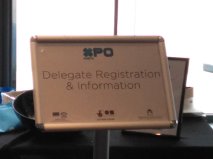One of the aims of my bursary led activity is to engage in opportunities to network and learn from other practitioners – now living in a rural area, I assumed this would mean always having to travel. Indeed this was brought up at a recent forum – if you live in a rural area, you accept that travelling potentially long distances is a factor in taking part in cultural activity (indeed in any activity – work/medical care/food shopping etc.) and travelling for and hour or more to attend a conference or evening event is normal. Conversely two weeks ago XpoNorth was held here in the Highlands, which instead brought the people here – to a 2 day creative industry festival.
This festival mainly covers music, writing, publication, design, screen and fashion/textiles but not so much on the visual art side. I was still keen to go along as there were a number of networking events, screenings and panels I wanted to see. One of the best things about XpoNorth is that it is free to attend – making it accessible to so many people from the area, indeed I saw what seemed to be quite a varied demographic (certainly in the events I attended).
I attended a number of different panels and events over the two days. On the whole, when a single speaker was talking about a specific theme the presentation was a lot more successful and interesting/relevant than the panel discussions I went to. Panel discussions depend a lot on the chair being able to steer conversation well and I felt this didn’t always happen. One of the best presentations was from a guy from the BBC talking/demonstrating how to make broadcast level film with just a smart phone – amusing and technical but ultimately could be very useful! Getting or offering something practical out of events like this is key, and it can be completely complimentary to talking about creative ideas. I feel it is so good to get something tangible to take away and inspire you to try something new or explore something further.
I also got the opportunity to see the premier of a film, directed by a friend of mine, Robin Haig. Hula, has already won Best Drama at BAFTA Scotland New Talent Awards 2016 and it duly proved to be a great film – there was also a Q & A after where Robin spoke about the possibility of developing more from this film and its characters, exciting and so great to see local talent recognised and flourishing.
The other big side of the festival was the live music from up and coming bands both local and from further afield – these were showcased in a number of venues around the city centre for both nights. We dotted around finding plenty to choose from until the small hours. It was fantastic to see so much activity going on in this place where so often it feels as if there is the need and talent for this to happen more regularly but there is something missing and stopping it or making it difficult to happen.
Which leads on to the other activity which happened co-incidentally right in the middle of all this – a public discussion about the creation of a creative centre in Inverness. WASPS have been pursuing planning of a creative hub. A survey of creatives was carried out last year and showed there was a definite need for this here. Progress has been made and there is even a building earmarked and 2/3rds of funding in place for this to happen. This would be a fantastic development if it goes ahead – it really does feel like there is a distinct venue missing in this city. There are so many creative people living and working here but lack of studio provision for artists and a place in which to gather and share and use as a creative hub is really missing. However, this project is still at an early stage – hopefully it will go ahead as planned and the uncertainties which have been thrown up post referendum do not take away the chance of this much needed space.
Lastly, I helped present the postcard project I had worked on with a small group of young people who got funding from the Highland Youth Arts Hub – a visiting artist who was working on a project (which some of the group will participate in) was presenting his work locally, so it was an ideal opportunity to add in the work the group had done. We had a little explanation and offered the audience to take some of the postcards at the end – something really informal which suited the young folk. They didn’t want a big formal presentation, just something to mark the conclusion of their project and show an audience what they had done. It worked really well and they loved the postcards (which they hadn’t seen printed before!). A reminder that not every presentation has to be big or official, it should be something appropriate to the project and experience of those taking part. A fitting conclusion to a worthwhile project, and a busy week.






